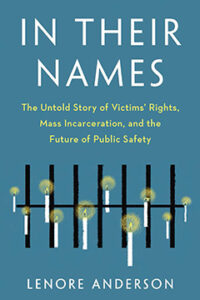
Prosecution Over Protection: How the Justice System Treats Entire Communities as Suspects
Lenore Anderson on the Politically Motivated Focus on Drug Convictionsr
In the spring of 2015, Shakyra Diaz walked into the Fifth District police station in her hometown of Cleveland, Ohio, to file a police report after her home was burglarized. As she entered the small storefront lobby, she saw a dazed-looking teen sitting at a table with a police officer. The girl looked to be about sixteen years old, with decorated fingernails and baggy clothes. She sat with her mother, who was holding a baby and speaking to her in Spanish, urging her daughter to talk to the officer sitting in front of them.
As Shakyra filled out paperwork, she overheard the girl slowly describe a horrific crime. Hesitant and trying to speak softly, the teen took a while to get out what she was trying to report. She told the officer that an older male acquaintance had forcibly taken her to a nearby hotel, trapped her in a room, and sexually assaulted her for three days until she escaped.
Shakyra was shocked at what she was hearing, and even more shocked when she witnessed the officer’s response. The officer began pressing the teenager for details with rapid-fire questions, and as the girl struggled to respond, he got increasingly frustrated. He slammed his hand on the table and screamed, “Do you want him to get away with this?” The rattled girl shut down even more. She stopped talking, sunk into her chair, and put her head down on the table.
When the officer kept pressing, the girl turned to her mother and begged to be allowed to leave. “I don’t want to be here,” she said. Alarmed, Shakyra walked over to talk to the officer. She suggested he seek out a female officer to help or, at the very least, continue taking the girl’s statement in a private room. The teenage girl looked up at her and mouthed “thank you.” Surprised by Shakyra’s interruption, the officer responded that there were no female officers there.
At the time, Shakyra was working as the policy director of Ohio’s American Civil Liberties Union and had a rolodex that included many local officials. Unsatisfied with the officer’s response, she contacted Cleveland mayor Frank Jackson to tell him what she witnessed. The mayor asked his public safety director to investigate. Local officials had reason to be responsive to Shakyra’s concerns. For the last few years, the city had been reeling from an alarming media discovery: the majority of rape cases, hundreds reported each year, sat in file folders uninvestigated, with no testing of forensic evidence, no follow-up interviews, no arrests—nothing. “Disregard for this exact crime that this girl was reporting that day—that was a major issue that had been driving news headlines in Cleveland,” Shakyra recalled.
At the same time Cleveland officials were ignoring people facing real danger while driving crack pipe possessors into state prison, other cities across the country were showing similar patterns.
Public attention to local justice officials’ disregard for rape victims had begun to ramp up about five years prior to Shakyra walking into the police precinct. In 2009, Rachel Dissell and Leila Atassi, two investigative reporters with the Cleveland Plain Dealer, had uncovered more than four thousand rape kits sitting in boxes at the police department, untested, dating all the way back to 1993. After sifting through box after box, they learned that only 27 percent of all reported rapes in Cleveland ever made it from the police department’s files to the prosecutor’s office.
Of those 27 percent, few were ever charged by prosecutors. The reporters homed in on the scandal, writing about the topic nonstop and producing more than 150 stories over the course of the next few years. Their stories got attention. Local leaders set up a task force, the state attorney general offered help to expedite rape kit testing, state legislation was introduced, and cold case investigations finally started to move.
And still, after all this, Shakyra Diaz found a child, the victim of a brutal assault, being callously interrogated in the public lobby of her local police station. Per the mayor’s request, the city’s public safety director investigated the police station incident. After watching police lobby video recordings, he validated what Shakyra witnessed, and the officer was reprimanded. But Shakyra felt that officials were missing the bigger point. “This kind of intimidation and disregard has long-term consequences. This girl isn’t going to report again. That mentality this officer demonstrated, it was pervasive,” she explained.
The policy director’s dismay emanated not just from witnessing this disturbing incident but also from her deep familiarity with Cleveland’s other justice system priorities. At the ACLU, she had devoted hundreds of hours to pushing city officials to address an entirely different problem—police and prosecutors had been arresting growing numbers of Black Clevelanders for possession of drug paraphernalia, specifically crack pipes, and charging these cases as felonies. The Cleveland Police Department had a policy in place to send confiscated drug paraphernalia to the laboratory to test it for traces of drugs so that prosecutors could then pursue felony drug possession charges against those arrested with crack pipes (paraphernalia is a misdemeanor, whereas possession is a felony and is eligible for prison).
Crack pipe felony convictions were driving Black Clevelanders into state prison at alarming rates. For years, while the number of white arrestees for possession dropped, the number of Black arrestees rose, with 80 percent of those arrested for possession being people of color, despite similarities in drug use rates across racial demographic groups. And for years, judges and grand jury officials had raised alarm bells about the disparities.
Shakyra and a coalition of organizations had protested the practice and eventually called for an independent expert to review the data, a review that revealed that white defendants in the surrounding suburbs were charged with misdemeanors and diverted away from incarceration to treatment or community service, while Black Clevelanders caught with crack pipes were sent to prison. In response to the outcry and mounting evidence, the Cleveland Plain Dealer conducted its own analysis, uncovering and publicizing the same trend of high drug arrest rates and deep racial disparities.
With a front-row seat to the intricacies of how law enforcement handled both sexual assault cases and drug charges, Shakyra was struck by this completely upside-down set of public safety priorities. “The justice system had all the time in the world to pursue these simple possession cases, using crime lab resources to test crack pipes and incarcerate people. Meanwhile rape kits were sitting untested as officers belittled victims,” she recalled.
While extreme, Cleveland’s misplaced safety priorities were not unique. At the same time Cleveland officials were ignoring people facing real danger while driving crack pipe possessors into state prison, other cities across the country were showing similar patterns.
In Orange County, California, law enforcement took actions beyond simply increasing drug arrests: officials began manufacturing their own drugs to sell. In the 1990s, the Orange County Sheriff’s Department built its own crack manufacturing lab, made crack, and then supplied it to undercover police officers in Santa Ana, one of Orange County’s largest cities. The officers posed as drug dealers, sold it, and arrested the buyers for possession of crack. They orchestrated these “reverse sting” operations—where police pretended to be sellers instead of buyers—down the street from a middle school. “Undercover officers have tried to avoid sales to juveniles,” the Santa Ana police chief told the Los Angeles Times in a 1994 exposé on the scandalous practice.
More than four hundred people were arrested during the eighteen-month-long operation before a judge ordered an end to the program. Meanwhile, those same local officials struggled to address serious violent crime: less than 25 percent of homicide cases in Santa Ana resulted in an arrest or prosecution during the same time police were manufacturing crack, a tragic fact considering that the rate of homicide in Santa Ana was higher than the statewide or national average for much of the 1990s and the first decade of the 2000s. Despite the homicide crisis, the investigation of these murder cases chronically failed.
Focusing on crack pipes over rape kits reflects a set of financial and political decisions that beefed up the presence of the justice system, mostly in urban communities, but treated entire communities as if they were only communities of suspects.
Santa Ana police were not the only ones selling cop-made crack while violent crime grew. On the other side of the country, the sheriff’s department in Broward County, Florida (home of Fort Lauderdale), was sued for doing the same thing: manufacturing and selling crack to arrest people for possession. After the lawsuit reached the Florida Supreme Court, the court prohibited the “outrageous law enforcement conduct,” with Judge Harding noting that “it is incredible that law enforcement’s manufacture of an inherently dangerous controlled substance. . . can ever be for public safety.” Meanwhile, Fort Lauderdale has had homicide rates nearly double the national average for more than thirty years and has struggled with an inability to successfully investigate or prosecute homicides, with less than 30 percent of homicide investigations resulting in arrest on a consistent annual basis.
In cities like Cleveland, Santa Ana, and Fort Lauderdale, how could these be the public safety priorities? How could crack pipes ever be ahead of rape kits in the line for forensic review, or the arrest of people buying sheriff-manufactured drugs ever trump murder investigations? If concern for victims of violent crimes truly determined public safety priorities, vulnerable community members would not be ignored while aggressive enforcement of petty crimes soared. But for decades, these upside-down priorities persisted.
These priorities emerged for two main reasons: money and politics. First, the calls for law and order and victims’ rights were heeded through a massive transfer of cash to a justice system that has been better at declaring wars against phantom enemies than at identifying who is vulnerable to being hurt. As money increasingly flowed to criminal justice, allocation of the money focused attention on the wrong crimes, the wrong enemies, and the wrong approach. Justice agencies largely received financing for strategies that captured large numbers of people for low-level crimes—money was designated for surveillance and patrol rather than for complex investigations or community engagement for prevention.
Second, while surveillance budgets grew and focused a lot of law enforcement energy on petty arrests, political rhetoric was turning would-be victims into would-be criminals. Politicians glommed onto racialized stereotypes about who commits crimes and won votes by framing millions of people, many of whom were living in unsafe environments and vulnerable to being harmed, as people to be afraid of, instead of afraid for.
That left most victims, invisible under the hierarchy of harm, more likely to be targeted for arrest than protected from danger. In Cleveland, most of the rape kits that sat untested on shelves for years belonged to women of color, mostly low income—the very people who have been chronically disregarded as victims for generations. Black and Brown women in Cleveland were more likely to be among those targeted for drug possession arrests than to be treated with concern when reporting sexual assault.
In Santa Ana, many of the people killed by gun violence each year were Latino youths suspected of being in gangs, a group of youth that, despite being vulnerable, were never perceived as real victims. “Most of those who commit drive-by shootings know who they are shooting at,” the mayor of Santa Ana remarked, in an effort to reduce public concern about climbing homicides at the time. If the person reporting rape or being shot can be dismissed as not really a victim because they may be using drugs or may be in a gang, the horrific crimes committed against them don’t have to be taken as seriously.
Prioritizing crack pipes over rape kits is emblematic of what goes wrong when the call for protecting victims and improving safety is resolved by expanding the money and power of a justice system poisoned by the hierarchy of harm. Focusing on crack pipes over rape kits reflects a set of financial and political decisions that beefed up the presence of the justice system, mostly in urban communities, but treated entire communities as if they were only communities of suspects, not communities with victims deserving dignity and protection.
_________________________________

© 2022 Lenore Anderson. This excerpt originally appeared in In Their Names: The Untold Story of Victims’ Rights, Mass Incarceration, and the Future of Public Safety, published by The New Press. Reprinted here with permission.
Lenore Anderson
A former punk drummer turned prosecutor, Lenore Anderson is the founder and president of the Alliance for Safety and Justice. She is a former chief of policy at the San Francisco District Attorney’s Office, former director of public safety for the Oakland mayor, and the recipient of a James Irvine Foundation Leadership Award and a Frank Carrington Crime Victim Attorney Award. The author of In Their Names (The New Press), she lives in Oakland, California.



















